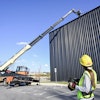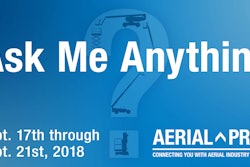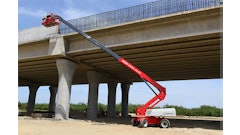
When the new ANSI A92.20 design standard is published, it will usher in many new requirements for MEWP manufacturers. Many of the new requirements may be unseen by users and operators, but a few will directly impact the operation of MEWPs that are manufactured to meet the new standard.
Platform load sensing and tilt sensor systems will mandate changes in the functionality of the MEWP when manufacturer limits are exceeded.
Most machines will actively monitor platform load and will not operate with normal control functionality if overloaded beyond rated capacity, except emergency controls. Users and operators will need to plan the work and identify the actual weight of all persons, tools and materials being placed in the work platform.
In addition to the existing required audible alarm for tilt sensor/alarm, MEWPs shall now be prevented from continuation of travel in the selected direction upon reaching the limits of the inclination of the chassis specified by the manufacturer.
These changes are NOT required on any MEWP designed and manufactured in compliance with prior standards in place when they were manufactured. This will result in a machine that looks like prior machines used but will not operate the same. A call for service to address it not functioning when you overload or exceed allowable tilt limits will only delay your work schedule as that machine IS FUNCTIONING PROPERLY.
To raise attention of this these potential issues, IPAF has developed an awareness campaign to place a sticker on MEWPs designed with these new systems.
IPAF encourages those with MEWPs designed to the new standard to place this sticker on the MEWP to make users and operators aware that it is equipped with new sensors and to read the manufacturer’s operation manual to understand how it is required to function.
A Load sensing system may also function different from MEWP to another. As an example, one manufacturer may activate load sensing only when the rate load limit is exceeded while another may have an light when 90% is reached, light and alarm at 95% and function loss at 100% of rated load.
Alternately a MEWP designed to prior standards may actually operate and lift the overloaded platform with all functions. This however can place persons in danger if operated in an overloaded or driving in slopes that exceed the manufacturer’s requirements.
These systems will require better planning and limit the ability to exceed tilt and rated load requirement that will improve operator safety.
![Tony Groat Edited 5b57430ec070e[1] Headshot](https://img.forconstructionpros.com/files/base/acbm/fcp/image/2024/06/Tony_Groat_edited.5b57430ec070e_1_.667c30792412c.png?auto=format%2Ccompress&crop=faces&fit=crop&h=48&q=70&w=48)


















![Building Angled Sm Edit 6050b8d213f1b[1]](https://img.forconstructionpros.com/mindful/acbm/workspaces/default/uploads/2025/09/building-angled-sm-edit6050b8d213f1b1.Ygq5aAos3b.png?ar=16%3A9&auto=format%2Ccompress&crop=focalpoint&fit=crop&fp-x=0.53&fp-y=0.23&fp-z=2&h=135&q=70&w=240)
